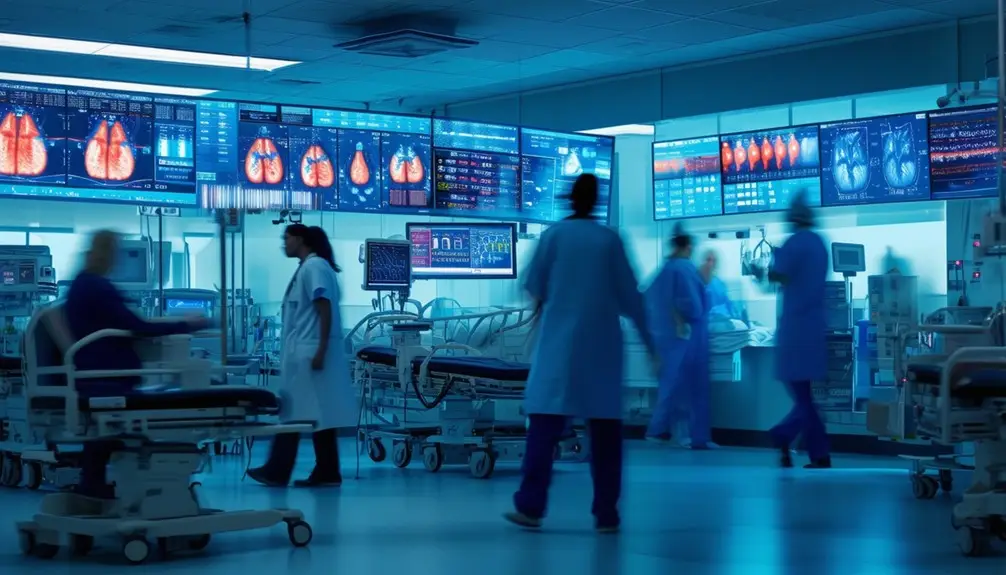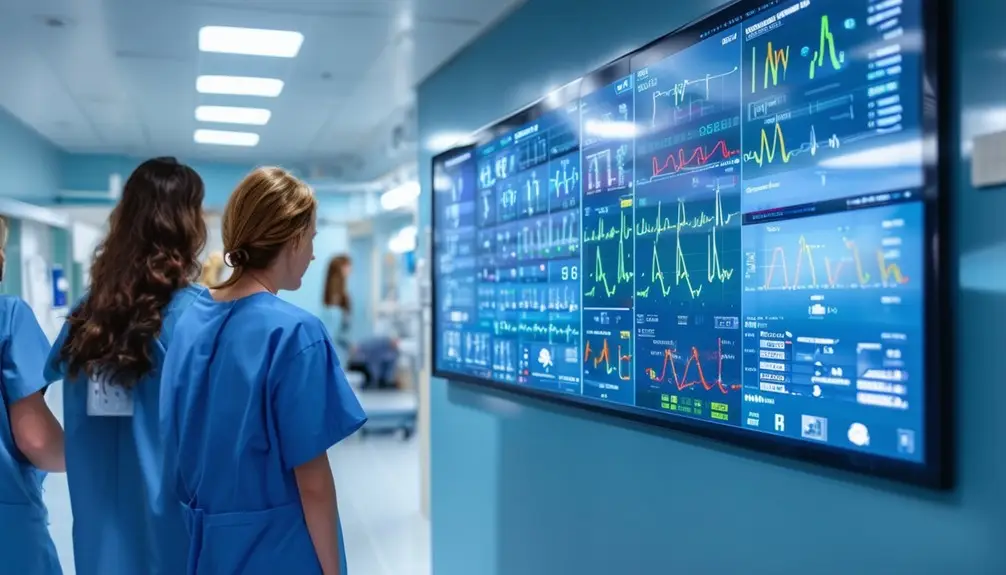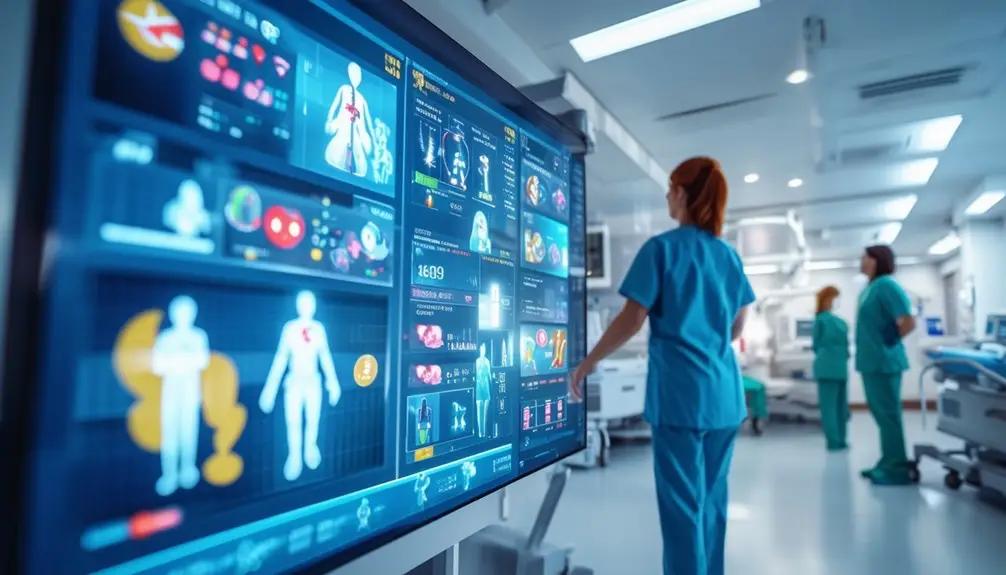Real-time ER patient status displays let you make quicker, better-informed decisions in emergency settings. They provide live patient metrics and status update alerts, ensuring you’re always aware of critical changes. Interactive dashboards visually present key healthcare metrics, supporting immediate triage and best resource allocation. These systems employ advanced encryption to keep patient data secure. Using devices like RTLS and staff badges, you can monitor patient flow and enhance safety. Integrating platforms like Striim enhances situational awareness and improves efficiency. Learn how these systems can transform your ER operations and provide continuous patient care updates.
Table of Contents
ToggleKey Takeaways
- Real-time ER dashboards monitor live patient metrics for quick decision-making.
- Status update alerts provide instant notifications on patient condition changes.
- Visualizations display data clearly for rapid assessment and intervention.
- Data security features include encryption and deidentification to protect patient privacy.
- Continuous monitoring and streaming analytics ensure up-to-date patient information.
Importance of Real-Time Data

Real-time data is essential for emergency rooms, enabling immediate patient triage and efficient resource allocation. You need instant access to accurate information to make informed decisions swiftly. This is where Striim’s real-time monitoring shines, offering you the ability to base your actions on live insights. When every second counts, these insights guarantee optimal patient care by guiding rapid decision-making.
Interactive dashboards from Striim provide visual representations of key healthcare metrics, allowing you to assess the situation quickly. These dashboards display live data, so you can see changes as they happen and adapt your strategy accordingly. This immediacy is crucial for patient triage, helping you prioritize cases based on urgency and allocate resources where they’re needed most.
Efficient communication facilitated by Striim enhances collaboration among your healthcare team, ensuring everyone is on the same page. With almost zero latency in querying streaming data, you can trust that the information you’re acting on is current. This level of responsiveness is vital for maintaining high standards of patient care in time-sensitive environments. By leveraging real-time data, you can make better decisions faster, ultimately saving lives and improving outcomes in emergency rooms.
Key Features of ER Dashboards

You can monitor real-time patient metrics to streamline decision-making and improve care efficiency. Status update alerts keep you informed about important changes instantly, ensuring timely interventions. These features are essential for maintaining an ideal and responsive emergency department environment.
Live Patient Metrics
ER dashboards provide a deep view of live patient metrics, offering critical insights into current diagnoses, room occupancy, and wait times. With real-time updates, you can monitor patient status as it changes, ensuring you’re always aware of the latest developments. These dashboards capture the pulse of emergency room activities, enhancing your ability to manage patient flow and maintain high levels of operational efficiency.
Visualizations play a pivotal role, presenting intricate data in an easily digestible format. This enables you to quickly assess how resources are being utilized and where adjustments might be needed. Provider analytics offer a thorough look at department performance, helping you identify trends and make informed decisions about resource allocation.
Status Update Alerts
Building on the insights from live patient metrics, status update alerts on ER dashboards offer real-time information on patient conditions and department status, enhancing situational awareness and response times. These alerts help healthcare professionals track patient progress, prioritize care, and make timely decisions during emergencies. By utilizing data effectively, staff members can monitor critical conditions, track patient locations, and oversee wait times efficiently.
Key features of these status update alerts include color-coded signals that quickly draw attention to critical situations, ensuring no time is wasted. This real-time monitoring system facilitates efficient resource allocation and streamlines communication among healthcare teams, ultimately improving patient care outcomes.
| Feature | Description |
|---|---|
| Color-coded alerts | Visual signals for critical conditions to prioritize immediate attention. |
| Patient location tracking | Monitors patient movement within the ER for better management and updates. |
| Wait time monitoring | Keeps track of patient wait times to enhance service efficiency. |
| Real-time updates | Continuous data feed for the most current patient and department status. |
| Efficient communication | Streamlines information sharing among staff for coordinated care efforts. |
Real-time status update alerts are indispensable in emergency settings, where every second counts. By integrating these features into ER dashboards, healthcare professionals can respond promptly and effectively to patient needs, ensuring optimal care and safety.
Data Security and Privacy
When considering real-time ER patient status displays, you must prioritize data security and privacy. Use encryption and secure storage to protect sensitive information, and guarantee that data is deidentified whenever possible. By doing so, you align with industry standards and regulations, safeguarding both patient confidentiality and system integrity.
Encryption and Secure Storage
Protecting the security and privacy of patient data, Striim employs advanced encryption and secure storage practices in real-time ER patient status displays. Patients’ sensitive information in the emergency room is safeguarded through robust data encryption, making certain that all real-time displays of patient status remain secure and compliant with industry regulations.
Striim’s encryption measures shield patient data by converting it into an unreadable format for unauthorized users. This guarantees that sensitive information, such as patient conditions and medical history, stays confidential and inaccessible to potential breaches. Secure storage practices further strengthen this protection by maintaining the integrity of the data, ensuring it is both safe from external threats and readily accessible to authorized medical personnel.
In the high-paced environment of an emergency room, real-time displays of patient status are essential. Striim’s dedication to data security protocols ensures that these displays operate without compromising patient privacy. Their focus on networking security prevents unauthorized access, ensuring that patient data remains protected and that healthcare providers can rely on the integrity and confidentiality of the information.
Deidentified Information Usage
Leveraging anonymized information, the ER dashboard maintains patient privacy while integrating seamlessly with the clinical workflow. By using anonymized patient data, the dashboard guarantees that patient anonymity is preserved. This method allows for the protection of patient confidentiality without losing the crucial, real-time insights necessary for efficient operation.
Incorporating anonymized information into the ER dashboard offers several key benefits:
- Enhanced Patient Privacy: Anonymization protocols ensure that sensitive patient data remains confidential, safeguarding patient privacy.
- Seamless Data Integration: The use of anonymized information enables smooth patient data integration within the clinical workflow, allowing healthcare professionals to access essential details without breaching confidentiality.
- Real-Time Updates: The real-time ER dashboard can provide continuous updates without compromising patient anonymity, ensuring timely and informed decision-making.
- Regulatory Compliance: Utilizing anonymized information helps meet regulatory requirements for data protection and patient confidentiality, reducing legal risks.
Enhancing Patient Flow

Efficient patient flow in the emergency department hinges on streamlined communication, ideal resource allocation, and real-time visibility into patient status. To improve patient flow, leveraging real-time data analytics is crucial. By implementing real-time data analytics, you can monitor patient statuses continuously, optimizing resource utilization. Streaming data from patient monitors and wearables provides up-to-date health metrics, guaranteeing timely interventions and enhancing patient safety.
In the ED, utilizing RTLS devices and staff location badges can greatly streamline workflow. These tools enable precise tracking of both patients and medical personnel, facilitating quicker response times and more efficient care delivery. RTLS technology also supports healthcare monitoring by providing discreet alerts, ensuring a safer working environment.
Integrating nurse call systems and patient wearables enhances communication channels, allowing for quicker identification of patient needs and adjustments in care plans. This real-time visibility into patient statuses ensures that resources are allocated where they are most needed, thereby improving overall ED efficiency.
Equipment and asset tracking through asset tags further expedite critical care provision, ensuring essential medical tools are readily available when required. This comprehensive approach promotes a seamless, efficient emergency department, ultimately improving patient outcomes.
Integration With Striim

Integrating Striim’s real-time data platform with ER patient status displays transforms emergency department efficiency and patient care. Striim’s seamless data integration and streaming analytics offer unmatched advantages for healthcare professionals managing the emergency department (ED). By incorporating real-time data dashboards, you can monitor ongoing patient data, enabling faster and more informed decision-making.
When you utilize Striim, you can expect the following enhancements:
- Enhanced Decision-Making: Real-time processing of patient data allows you to make immediate and precise decisions, optimizing patient outcomes.
- Efficient Resource Allocation: With up-to-date visual representation of patient statuses, you can allocate resources more effectively, guaranteeing critical cases receive prompt attention.
- Improved Situational Awareness: Striim’s dashboard development features provide a thorough view of the ED’s flow, enhancing your situational awareness and operational efficiency.
- Ongoing Monitoring: Striim’s streaming analytics ensure that patient data is continuously updated, providing a dynamic picture of the emergency department’s status.
Usability and Feedback

Evaluating the usability and feedback of real-time ER patient status displays reveals key insights into their impact on emergency department operations. Participants, including ED physicians and nurses, rated the dashboard’s usability using the System Usability Scale (SUS) and Situation Awareness Index (SAI). With an average SUS score of 67.6 points, the dashboard demonstrated marginally high acceptability and usability. This score reflects that the dashboard is relatively easy to learn and use, with minimal technician support required.
The SAI score of 3.87 points, particularly higher among physicians, underscores the dashboard’s effectiveness in supporting concentration and information quality. This enhanced situational awareness is vital for clinical decision-making, enabling ED staff to prioritize tasks efficiently.
Real-time dashboards significantly influence workflow support by aiding information delivery. They streamline the process, ensuring that critical patient information is readily accessible, thereby enhancing the emergency department’s overall efficiency. By improving situational awareness, these dashboards contribute to more informed and timely clinical decisions.
Conclusion
Just imagine the power in your hands—real-time ER patient status displays. They’re not just tools; they’re revolutionizing patient care. Picture seamless data flow, impeccable security, and unprecedented efficiency. With Striim integration, the possibilities are endless. But the real question is: are you ready to transform your ER? Embrace this technology, and you’ll enhance patient flow, guarantee privacy, and get real-time feedback. Your ER’s future hinges on this. Are you prepared to take the leap?
Frequently Asked Questions
What Is an ED Dashboard?
An ED dashboard is a real-time tool you can use to monitor patient status and department performance. It enhances decision-making with visual data, improving workflow efficiency and patient care in high-pressure emergency department environments.
What Is Real-Time Patient Data?
Imagine a river constantly flowing, never stopping. Real-time patient data is like that, providing continuously updated information that helps you make immediate, informed decisions, optimizing care, improving outcomes, and enhancing resource allocation in healthcare settings.
Related posts:
 Streamline Operations: Enhance Efficiency with Digital Patient Data
Streamline Operations: Enhance Efficiency with Digital Patient Data
 From ER to Specialists: Comprehensive Digital Scheduling Solutions for Hospitals
From ER to Specialists: Comprehensive Digital Scheduling Solutions for Hospitals
 Tech Meets Medicine: Enhancing Patient Experience with Smart Appointments
Tech Meets Medicine: Enhancing Patient Experience with Smart Appointments
 Elevate Patient Care Coordination: Electronic Status Boards for Busy Hospitals
Elevate Patient Care Coordination: Electronic Status Boards for Busy Hospitals
